
Chocolate box rainbow - an old scenic cliche - from the land of the much, much, much older Rainbow Serpent.The colour spectrum arches over Tyto Wetlands in Ingham, Tropical North Queensland, where I watch birds and other wildlife - including the present-day Rainbow Serpent - most days.
The Rainbow Serpent's shaping of all land and waterways is a foundation stone of much Aboriginal mythology, thus it winds back 50,000 to 60,000 years.
The snake that seems most likely to have inspired the many tales among more than two hundred language groups - most now long lost - is limited in Australia to a thin northeastern area (roughly 1000km x 100km).
Amethyst Pythons also inhabit Papua New Guinea and parts of Indonesia. So there may be clues to the path to Australia by the first Aborigines in the distribution of Morelia amethistina.
But snake fossils are rare because the bones are so fragile. The pythons perhaps had a wider range across northern Australia that has vanished over, say, the last 30,000 years.
Also known as Scrub Python, the snake is now rarely over five metres long. Old reports of 8m snakes seem founded on stretched, sloughed skins. However, a living specimen in the pioneering sugar cane farming days of the 1890s was measured at 7m. Shipped south to Sydney in a barrel, it was reported to have overheated and died.

The animal pictured is about 4m. It appeared 14 times through 2007 in a one-tree island close to a Tyto lookout knoll, swimming out at night and spending between two and six days and nights coiled and largely concealed up in the melaleuca (paperbark). The magnificent colours are often muted by skin condition and angle of light.
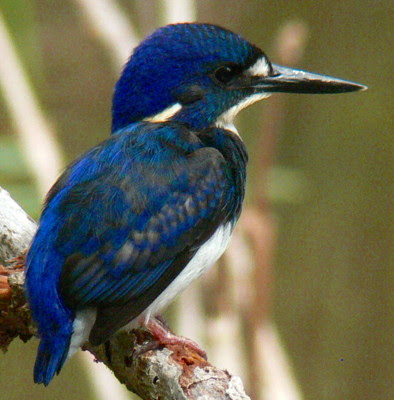 PLENTY of Australians live to fish, far fewer fish to live. Number among the latter, the Little Kingfisher, world's smallest. At 11-13cm it's barely more than half the size of the 'standard' Forest and Sacred species. And it is dwarfed by the Laughing Kookaburra (41-47cm) and the Blue-winged Kookaburra (38-40cm), which are giant kingfishers - and among a rare few Australian bird species to retain an Aboriginal name.
PLENTY of Australians live to fish, far fewer fish to live. Number among the latter, the Little Kingfisher, world's smallest. At 11-13cm it's barely more than half the size of the 'standard' Forest and Sacred species. And it is dwarfed by the Laughing Kookaburra (41-47cm) and the Blue-winged Kookaburra (38-40cm), which are giant kingfishers - and among a rare few Australian bird species to retain an Aboriginal name.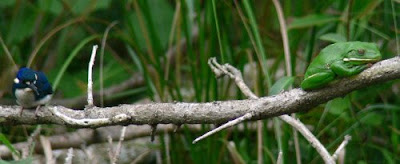 A Little Kingfisher (Alcedo pusilla) shares a branch with a White-lipped Green Tree Frog, a bird eater (see earlier post), but not usually a threat to an alert mature bird.
A Little Kingfisher (Alcedo pusilla) shares a branch with a White-lipped Green Tree Frog, a bird eater (see earlier post), but not usually a threat to an alert mature bird.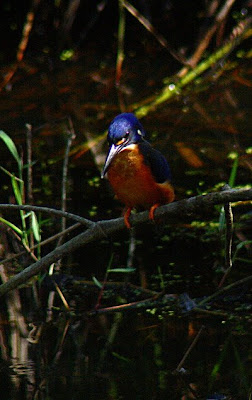 Most of Australia's 10 kingfisher species would as soon pounce on ground prey as dive into water for fish. A second exception to such preference is the Azure Kingfisher (Alcedo azurea), pictured in a so-so photo saved by a shaft of light.
Most of Australia's 10 kingfisher species would as soon pounce on ground prey as dive into water for fish. A second exception to such preference is the Azure Kingfisher (Alcedo azurea), pictured in a so-so photo saved by a shaft of light. 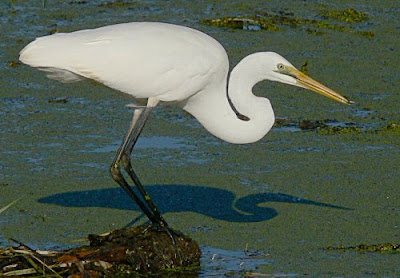


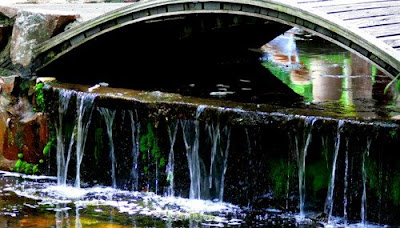
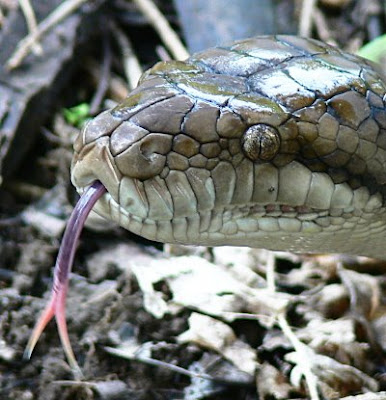



 The animal pictured is about 4m. It appeared 14 times through 2007 in a one-tree island close to a Tyto lookout knoll, swimming out at night and spending between two and six days and nights coiled and largely concealed up in the melaleuca (paperbark). The magnificent colours are often muted by skin condition and angle of light.
The animal pictured is about 4m. It appeared 14 times through 2007 in a one-tree island close to a Tyto lookout knoll, swimming out at night and spending between two and six days and nights coiled and largely concealed up in the melaleuca (paperbark). The magnificent colours are often muted by skin condition and angle of light.

